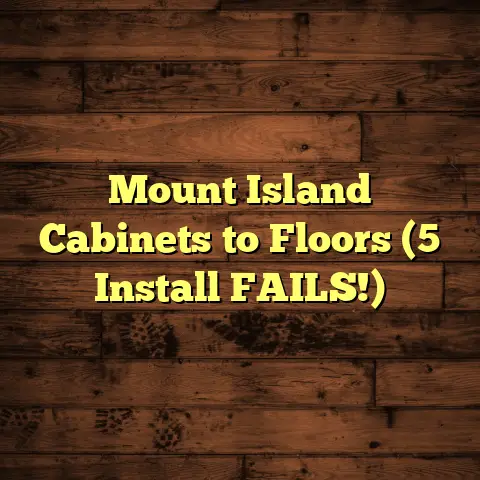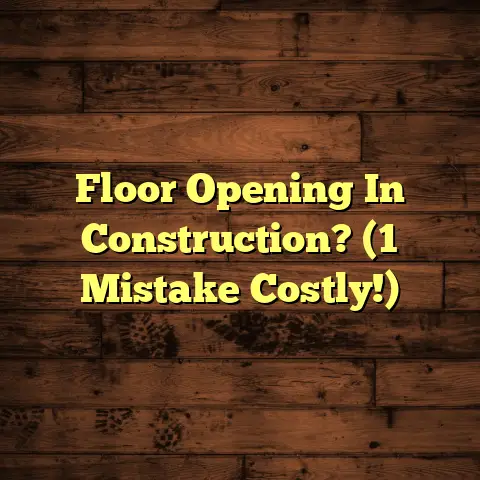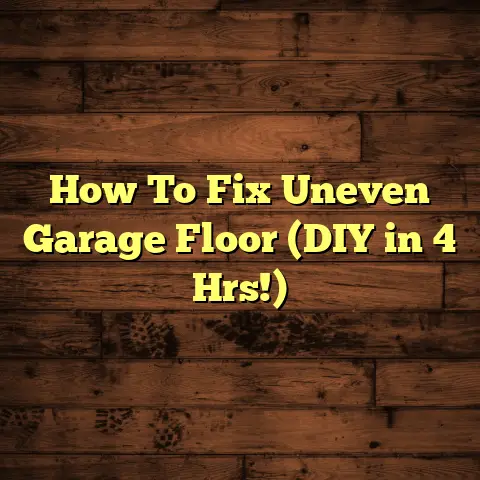Is Mold On Concrete Dangerous? (4 Health Risks!)
I’ve seen it all when it comes to floors, and one thing that always gets my attention is mold.
It’s sneaky, it’s persistent, and it can be a real headache, especially when it decides to set up shop on concrete.
If you’re like me, you probably love your pets like family. That’s why I wanted to write this article.
I often get asked, “Is mold on concrete dangerous?”
The short answer is a resounding YES!
But the real question is, how dangerous? And what can we do about it, especially to keep our furry friends safe?
Mold isn’t just an eyesore; it can pose serious health risks, not only to us but also to our beloved pets.
Think about it: basements, garages, and outdoor patios – these concrete-heavy areas are prime real estate for mold growth, thanks to moisture buildup.
And if you’re a pet owner, you know those curious noses and paws are always exploring!
In this article, I’m going to break down the dangers of mold on concrete, focusing on four significant health risks.
I’ll also share some pet-friendly strategies for both preventing and remediating mold.
Let’s dive in and get you equipped with the knowledge you need to protect your family and your pets from the hidden dangers of mold.
Section 1: Understanding Mold and Its Growth
So, what exactly is mold?
In simple terms, mold is a type of fungi.
Think of it as nature’s recycler.
It breaks down organic matter, like dead leaves and wood.
Outdoors, it plays a vital role in the ecosystem, but indoors? Not so much.
Mold thrives in damp environments, and concrete, while seemingly solid, can be surprisingly porous.
This means that moisture can seep in, creating the perfect breeding ground for mold.
To get a bit more technical, mold reproduces by releasing tiny spores into the air.
These spores are everywhere – inside and outside.
When they land on a surface with the right conditions – moisture, warmth, and a food source (even dust can do!) – they start to grow.
Here’s a quick rundown of the key conditions that contribute to mold growth on concrete:
- Moisture: This is the big one. Leaks, condensation, flooding, even high humidity can provide the moisture mold needs.
- Temperature: Mold generally prefers temperatures between 40°F and 100°F (4°C and 38°C).
- Organic Material: Mold feeds on organic materials. Dust, dirt, and even some types of paint can provide a food source.
- Poor Ventilation: Stagnant air allows moisture to linger, creating a more favorable environment for mold growth.
Now, let’s talk about the different types of mold you might encounter.
You’ve probably heard of “black mold,” but there are many other varieties, each with its own characteristics.
Here are a few common ones I see regularly:
- Aspergillus: This is a very common type of mold, and some species can cause allergic reactions and respiratory problems. It often appears as green or yellow patches.
- Cladosporium: This mold is often found on plants and in soil, but it can also grow indoors. It’s usually black or green and can cause allergic reactions.
- Penicillium: This mold is famous for its role in producing penicillin, but it can also be a common indoor mold. It often appears as blue-green or greenish-yellow.
- Stachybotrys chartarum: This is the infamous “black mold.” It’s a greenish-black mold that’s often associated with serious health problems. It requires very wet conditions to grow.
Knowing what these molds look like can help you identify potential problems early.
The key takeaway here is that prevention is always better than cure.
Especially in homes with pets, taking proactive measures to prevent mold growth is essential.
Think about it: our furry friends spend a lot of time on the floor, sniffing around and potentially coming into contact with mold spores.
Keeping your home dry, well-ventilated, and clean can go a long way in protecting both your family and your pets from the dangers of mold.
Section 2: Health Risks Associated with Mold on Concrete
Okay, now let’s get to the heart of the matter: the health risks associated with mold on concrete.
I’ve seen firsthand how mold can impact people’s health, and it’s not pretty.
And remember, our pets are even more vulnerable because they’re closer to the ground and have a tendency to lick and sniff everything!
Here are four significant health risks you need to be aware of:
Risk 1: Respiratory Issues
Mold spores are tiny and easily become airborne.
When we inhale them, they can irritate our respiratory system, leading to a range of problems.
For people with asthma or allergies, mold exposure can trigger attacks and worsen symptoms.
But even healthy individuals can experience coughing, wheezing, and shortness of breath.
And what about our pets?
They’re even more susceptible to respiratory issues from mold exposure.
Their respiratory systems are smaller and more sensitive than ours.
I’ve seen dogs develop chronic coughs and cats experience increased sneezing and nasal discharge after being exposed to mold.
In fact, a study by the American Veterinary Medical Association found that dogs living in moldy environments were more likely to develop respiratory infections.
| Study | Finding |
|---|---|
| AVMA Research | Dogs living in moldy homes showed a significantly higher incidence of respiratory infections. |
Here’s a personal story: a client of mine, Sarah, had a beautiful Golden Retriever named Buddy.
Buddy started developing a persistent cough that wouldn’t go away.
After several vet visits, they discovered mold growing in Sarah’s basement, right where Buddy loved to nap.
Once the mold was remediated, Buddy’s cough cleared up within a few weeks.
It was a clear reminder of how much our pets rely on us to keep their environment safe.
Risk 2: Skin Irritation and Allergies
Direct contact with mold can cause skin irritation and allergic reactions in both humans and pets.
Mold spores can trigger an immune response, leading to itching, redness, and rashes.
This is especially common in areas where the skin is thin or sensitive, like the face, neck, and paws.
For pets, the symptoms can be particularly distressing.
You might notice your dog scratching excessively, developing bald spots, or experiencing inflammation of the skin.
Cats might groom themselves excessively, leading to hair loss and skin lesions.
And remember, a pet’s fur can actually harbor mold spores, making the problem even worse.
Dr. Emily Carter, a veterinarian I often collaborate with, explains it this way: “A pet’s coat can act like a sponge, trapping mold spores and creating a warm, moist environment where they can thrive. This can lead to chronic skin problems that are difficult to treat.”
If you notice your pet scratching more than usual or developing any skin issues, it’s important to consult with your vet.
They can perform allergy testing and recommend appropriate treatment options.
Risk 3: Neurological Effects
This is where things get a bit more serious.
Certain types of mold produce mycotoxins, which are toxic substances that can have neurological effects on both humans and animals.
Mycotoxins can affect the brain and nervous system, leading to a range of symptoms, including:
- Headaches
- Memory problems
- Difficulty concentrating
- Mood changes
- Seizures
While the research on the neurological effects of mold is still ongoing, there have been some concerning findings.
A study published in the journal Neurotoxicology and Teratology found that exposure to certain mycotoxins can impair cognitive function in animals.
And in humans, there have been reports of neurological symptoms in people exposed to mold in their homes.
For pets, the neurological effects of mold can be particularly alarming.
I’ve heard stories of dogs experiencing seizures, disorientation, and changes in behavior after being exposed to mold.
Cats might become lethargic, lose their appetite, or develop tremors.
Some of the mold types known for producing mycotoxins include Stachybotrys chartarum (black mold), Aspergillus, and Penicillium.
These molds are often found in damp, poorly ventilated areas, like basements and crawl spaces.
If you suspect that you or your pet are experiencing neurological symptoms related to mold exposure, it’s crucial to seek medical attention immediately.
Risk 4: Long-Term Health Consequences
Prolonged exposure to mold can have serious long-term health consequences, especially for vulnerable populations like children, the elderly, and people with weakened immune systems.
It can also significantly impact our pets.
Chronic mold exposure can lead to:
- Weakened immune system
- Increased susceptibility to infections
- Chronic respiratory problems
- Increased risk of certain cancers
Dr. David Miller, a leading expert in indoor air quality, puts it this way: “Mold exposure is like a slow poison. Over time, it can weaken your body’s defenses and make you more vulnerable to a wide range of illnesses.”
For pets, the long-term effects of mold exposure can be devastating.
I’ve seen dogs develop chronic respiratory diseases and cats experience kidney damage after years of living in moldy environments.
And remember, pets have shorter lifespans than humans, so the effects of mold exposure can manifest more quickly.
That’s why it’s so important to address mold issues promptly and prevent them from recurring.
The key takeaway here is that mold is not something to be taken lightly.
It can pose serious health risks to both humans and pets, and the long-term consequences can be devastating.
By understanding the dangers of mold and taking proactive steps to prevent and remediate it, you can protect your family and your pets from its harmful effects.
Section 3: Pet-Friendly Mold Prevention Strategies
Alright, let’s get practical.
Now that we know the dangers of mold, let’s talk about how to prevent it from growing in the first place.
The good news is that there are plenty of pet-friendly strategies you can use to keep your home mold-free.
Here are some of my top recommendations:
Moisture Control
This is the most important factor in preventing mold growth.
Mold needs moisture to thrive, so controlling moisture levels is crucial.
Here are some effective methods for controlling moisture in concrete areas:
- Use a Dehumidifier: Dehumidifiers remove excess moisture from the air, making it less hospitable to mold. Aim for a humidity level between 30% and 50%.
- Ensure Proper Ventilation: Good ventilation helps to dry out damp areas and prevent moisture buildup. Open windows and doors whenever possible, and use fans to circulate air.
- Fix Leaks Promptly: Leaky pipes, roofs, and windows can all contribute to moisture problems. Repair any leaks as soon as you notice them.
- Improve Drainage: Make sure that water drains away from your foundation properly. Clean gutters and downspouts regularly, and consider installing French drains to redirect water away from your home.
Non-toxic Cleaning Solutions
When it comes to cleaning mold from concrete surfaces, it’s important to use pet-safe cleaning products.
Many commercial cleaners contain harsh chemicals that can be harmful to pets.
Here are some non-toxic cleaning solutions that are effective at removing mold:
- Vinegar: Vinegar is a natural disinfectant and can kill many types of mold. Mix equal parts vinegar and water in a spray bottle, spray the affected area, let it sit for an hour, and then scrub with a brush.
- Baking Soda: Baking soda is a mild abrasive that can help to remove mold from concrete. Mix baking soda with water to form a paste, apply it to the affected area, let it sit for a few minutes, and then scrub with a brush.
- Hydrogen Peroxide: Hydrogen peroxide is a powerful disinfectant that can kill mold and bacteria. Spray hydrogen peroxide on the affected area, let it sit for 10 minutes, and then scrub with a brush.
- Tea Tree Oil: Tea tree oil is a natural antifungal and antibacterial agent. Mix a few drops of tea tree oil with water in a spray bottle, spray the affected area, and let it sit for an hour.
Important Note: Always test any cleaning solution on a small, inconspicuous area first to make sure it doesn’t damage the concrete.
Barrier Methods
Applying sealants and coatings to concrete surfaces can help to prevent mold growth by creating a barrier against moisture.
Here are some pet-safe options:
- Concrete Sealers: Choose a concrete sealer that is specifically designed for use in pet-friendly environments. Look for sealers that are low-VOC (volatile organic compounds) and non-toxic.
- Epoxy Coatings: Epoxy coatings are durable and waterproof, making them an excellent choice for preventing mold growth in damp areas. Make sure to choose an epoxy coating that is safe for pets and has low VOCs.
- Mold-Resistant Paint: There are paints specifically formulated to resist mold growth. These paints contain antimicrobial agents that inhibit the growth of mold and mildew.
Regular Maintenance
Regular inspections and maintenance of concrete areas are essential for preventing mold development.
Here are some tips to keep in mind:
- Inspect Regularly: Check concrete areas for signs of mold growth, such as discoloration, musty odors, and visible mold.
- Clean Regularly: Clean concrete surfaces regularly to remove dirt, dust, and debris that can provide a food source for mold.
- Address Issues Promptly: If you notice any signs of mold growth, address the issue immediately. The longer you wait, the worse the problem will become.
By following these pet-friendly mold prevention strategies, you can create a healthy and safe environment for your family and your pets.
Section 4: Remediation of Existing Mold
Okay, so what happens if you already have mold growing on your concrete?
Don’t panic!
There are steps you can take to remediate the problem and prevent it from recurring.
Identifying Mold
The first step is to identify the mold and assess the extent of the contamination.
Here are some things to look for:
- Visual Signs: Mold can appear as discoloration, stains, or fuzzy growth on concrete surfaces. It can be black, green, brown, or white.
- Musty Odor: Mold often has a distinct musty or earthy odor. If you notice a musty smell in a concrete area, it’s a good indication that mold is present.
- Water Damage: Look for signs of water damage, such as water stains, dampness, and peeling paint. These are often indicators of underlying moisture problems that can lead to mold growth.
DIY vs. Professional Help
Once you’ve identified the mold, you need to decide whether to tackle the remediation yourself or hire a professional.
Here are some factors to consider:
- Size of the Affected Area: If the mold is limited to a small area (less than 10 square feet), you may be able to handle the remediation yourself. However, if the mold is widespread, it’s best to call in a professional.
- Type of Mold: If you suspect that you have black mold (Stachybotrys chartarum), it’s important to hire a professional. Black mold can produce mycotoxins that are harmful to your health.
- Your Health: If you have allergies, asthma, or a weakened immune system, it’s best to avoid DIY mold remediation. Exposure to mold can exacerbate these conditions.
- Pet Safety: If you have pets, it’s important to take extra precautions during mold remediation. Keep your pets away from the affected area and make sure to use pet-safe cleaning products.
Safe Removal Techniques
If you decide to tackle the mold remediation yourself, it’s important to follow safe removal techniques.
Here are some tips:
- Wear Protective Gear: Wear gloves, a mask, and eye protection to avoid contact with mold spores.
- Isolate the Area: Seal off the affected area with plastic sheeting to prevent mold spores from spreading to other parts of your home.
- Ventilate the Area: Open windows and doors to ventilate the area and help to dry out the concrete.
- Clean the Mold: Use a pet-safe cleaning solution to clean the mold from the concrete. Scrub the affected area with a brush and then wipe it down with a clean cloth.
- Dispose of Contaminated Materials: Dispose of contaminated materials, such as rags, brushes, and plastic sheeting, in a sealed bag.
Post-Remediation Care
After you’ve removed the mold, it’s important to take steps to prevent it from recurring.
Here are some tips:
- Dry the Area Thoroughly: Use fans and dehumidifiers to dry the area completely.
- Address Moisture Problems: Fix any leaks or moisture problems that contributed to the mold growth.
- Improve Ventilation: Improve ventilation in the area to prevent moisture buildup.
- Monitor Regularly: Monitor the area regularly for signs of mold growth.
By following these steps, you can effectively remediate mold on concrete and prevent it from recurring, creating a healthy and safe environment for your family and your pets.
Conclusion
So, there you have it!
We’ve covered a lot of ground in this article, from understanding what mold is and how it grows to identifying the health risks associated with mold exposure and implementing pet-friendly prevention and remediation strategies.
The key takeaway is this: mold on concrete is a serious issue that can pose significant health risks to both humans and pets.
It’s important to be vigilant in maintaining a mold-free environment, ensuring the safety and well-being of your beloved pets.
Remember those four health risks we discussed:
- Respiratory Issues: Mold spores can trigger asthma, allergies, and chronic lung conditions.
- Skin Irritation and Allergies: Direct contact with mold can cause itching, redness, and rashes.
- Neurological Effects: Mycotoxins produced by certain molds can affect the brain and nervous system.
- Long-Term Health Consequences: Prolonged exposure to mold can weaken the immune system and increase the risk of chronic illnesses.
But don’t despair!
By taking proactive steps to prevent and remediate mold, you can protect your family and your pets from its harmful effects.
So, what’s your next step?
I encourage you to regularly check your home for mold, especially in concrete areas like basements, garages, and outdoor patios.
If you find mold, take action immediately.
Whether you choose to tackle the remediation yourself or hire a professional, the important thing is to address the issue promptly and prevent it from recurring.
Your health and the health of your pets depend on it!
And remember, a little bit of prevention goes a long way.
By controlling moisture levels, using non-toxic cleaning solutions, and maintaining good ventilation, you can create a healthy and safe environment for everyone in your home.
Thanks for taking the time to read this article.
I hope you found it helpful and informative.
If you have any questions or comments, please feel free to leave them below.
And remember, I’m always here to help you with all of your flooring needs.
Stay safe and mold-free!





